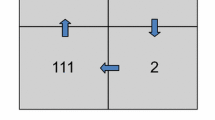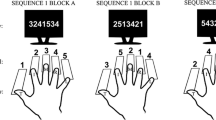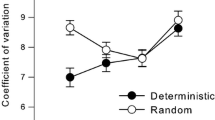Summary
This article examines the programming of relatively long sequences of action with the control of sequential movements being effected through the use of a tapping task involving a sequence of five taps. Subjects were required to tap with their right hand at rates of 150, 200, and 250 ms. There were two conditions, with subjects being required either to increase, in condition 1, or to decrease, in condition 2, the force at one of the five tap positions (all five tap positions were examined), then return to the previous force level. Changes in timing resulting from variations in the force characteristics have previously been discussed in terms of changes in the organizational time required ( Semjen, Garcia-Colera, & Requin, 1984). The current study breaks the intertap interval down into two separate components: the contact interval (finger in contact with the key) and the non-contact interval (interval preceding the tap). Although changes in the non-contact interval could be explained in terms of changes in the organizational time required, changes in the contact interval appeared to be a result of the mechanical changes in force.
Similar content being viewed by others
References
Baba, D. M., & Marteniuk, R. G. (1983). Timing and torque involvement in the organisation of a rapid forearm flexion. Quarterly Journal of Experimental Psychology, 35A, 323–331.
Desmedt, J. E. (1983). Size principle of motoneuron recruitment and the calibration of muscle force and speed in man. In J. E. Desmedt (Ed.), Motor control mechanisms in health and disease (pp. 227–251). New York: Raven Press.
Garcia-Colera, A., & Semjen, A. (1987). The organisation of rapid movement sequences as a function of sequence length. Acta Psychologica, 66, 237–250.
Garcia-Colera, A., & Semjen, A. (1988). Distributed planning of movement sequences. Journal of Motor Behavior, 20, 341–367.
Glencross, D. J., Pick, J. P., & Barrett, N. C. The coordination of bi-manual synchronous and alternating tapping sequences. Journal of Motor-Behavior (in press).
Henry, F. M., & Rogers, D. E. (1960). Increased response latency for complicated movements and a “memory drum” theory of neuromotor reactions. Research Quarterly, 31, 448–458.
Ivry, R. B. (1986). Force and timing components of the motor program. Journal of Motor Behavior, 18, 449–474.
Kasai, T., & Komiyama, T. (1990). Effects of varying force components on EMG reaction times of isometric ankle dorsiflexion. Human Movement Science, 9, 133–147.
Keele, S. W. (1981). Behavioral analysis of movement. In V. B. Brooks, (Ed.), Handbook of physiology, Section 1: The nervous system Vol II. Motor control. (pp. 1391–1414) Bethesda: American Physiological Society.
Keele, S. W., Cohen, A., & Ivry, R. (1990). Motor programs: Concepts and issues. In M. Jeannerod (Ed.), Attention and performance XIII: Motor representation and control (pp. 77 -110). Hillsdale, NJ: Lawrence Erlbaum.
Klapp, S. T., & Wyatt, E. P. (1976). Motor programming within a sequence of responses. Journal of Motor Behavior, 8, 19–26.
Semjen, A., & Garcia-Colera, A. (1986). Planning and timing of finger tapping sequences with a stressed element. Journal of Motor Behavior, 18, 3, 287–322.
Semjen, A., Garcia-Colera, A., & Requin, J. (1984). On controlling force and time in rhythmic movement sequences: The effect of stress location. Annals of the New York Academy of Sciences, 423, 168–182
Smith, A. M., Hepp-Reymond, M. C., & Wyss, U. R. (1975). Relation of activity in precentral cortical neurons to force and rate of force change during isometric contractions of finger muscles. Experimental Brain Research, 23, 315–332.
Sternberg, S., Knoll, R. L., & Turock, D. L. (1990). Hierarchical control in the execution of action sequences: Tests of invariance properties. In M. Jeannerod (Ed.), Attention and performance XIII:: Motor representation and control (pp. 1–55). Hillsdale, NJ: Lawrence Erlbaum.
Sternberg, S., Monsell, S., Knoll, R. L., & Wright, C. E. (1978). The latency and duration of rapid movement sequences: Comparisons of speech and typewriting. In G. E. Stelmach (Ed.), Motor control: issues and trends. New York: Academic Press.
Tauji, J., & Kato, M. (1973). Firing rate of individual motor units in voluntary contraction of abductor digiti minimi muscle in man. Experimental Neurology, 40, 771–783.
Tukey, J. W. (1949). Comparing individual means in the analysis of variance. Biometrics, 5, 99–114.
Vince, M. A., & Welford, A. T. (1967). Time taken to change the speed of a response. Nature, 213, 532–533.
Author information
Authors and Affiliations
Rights and permissions
About this article
Cite this article
Piek, J.P., Glencross, D.J., Barrett, N.C. et al. The effect of temporal and force changes on the patterning of sequential movements. Psychol. Res 55, 116–123 (1993). https://doi.org/10.1007/BF00419642
Issue Date:
DOI: https://doi.org/10.1007/BF00419642




